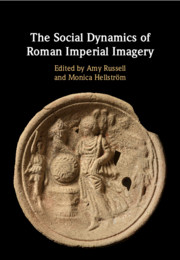Book contents
- The Social Dynamics of Roman Imperial Imagery
- The Social Dynamics of Roman Imperial Imagery
- Copyright page
- Contents
- Figures
- Contributors
- Acknowledgements
- Abbreviations
- 1 Introduction
- 2 The Altars of the Lares Augusti
- 3 Modelling the Emperor
- 4 Publica numina
- 5 Roman Emperors, Conquest, and Violence
- 6 Court Politics and Imperial Imagery in the Roman Principate
- 7 Local Aspirations and Statues of Emperors in Roman North Africa
- 8 The Altar of P. Perelius Hedulus in Carthage and the Social Aspects of Provincial Image-Making
- 9 Imagines et tituli
- 10 The Imperial Image in Media of Mechanical Reproduction
- 11 When Was an Imperial Image?
- Index
- References
1 - Introduction
Imperial Imagery and the Role of Social Dynamics
Published online by Cambridge University Press: 09 November 2020
- The Social Dynamics of Roman Imperial Imagery
- The Social Dynamics of Roman Imperial Imagery
- Copyright page
- Contents
- Figures
- Contributors
- Acknowledgements
- Abbreviations
- 1 Introduction
- 2 The Altars of the Lares Augusti
- 3 Modelling the Emperor
- 4 Publica numina
- 5 Roman Emperors, Conquest, and Violence
- 6 Court Politics and Imperial Imagery in the Roman Principate
- 7 Local Aspirations and Statues of Emperors in Roman North Africa
- 8 The Altar of P. Perelius Hedulus in Carthage and the Social Aspects of Provincial Image-Making
- 9 Imagines et tituli
- 10 The Imperial Image in Media of Mechanical Reproduction
- 11 When Was an Imperial Image?
- Index
- References
Summary
The introductory chapter explores the methodology of approaching imperial imagery, from definitions and categorisations to modes of analysis. Defining imperial imagery as imagery that relates to imperial power, the authors reject universal models that purport to encompass all aspects of the production and use of such images in favour of context-based approaches which focus on the ways in which they became embedded in local image systems. The authors single out social dynamics, a term borrowed from economics, sociology, and psychology indicating how large-scale phenomena are the sum of many individual interactions. Social dynamics gives a way to understand how and why imperial imagery was created and used in Roman society at all levels. Imperial imagery had roles to play beyond the emperor’s own sphere, and he was often neither its author nor its audience; instead, individuals used imperial images to communicate with their immediate neighbours, geographically and socially. Multiple users and viewers across the spatial and social spectrums of the empire (and beyond) brought their own experiences to imperial images, and to understand them, we must analyse them in their local contexts.
- Type
- Chapter
- Information
- The Social Dynamics of Roman Imperial Imagery , pp. 1 - 24Publisher: Cambridge University PressPrint publication year: 2020
References
- 3
- Cited by

